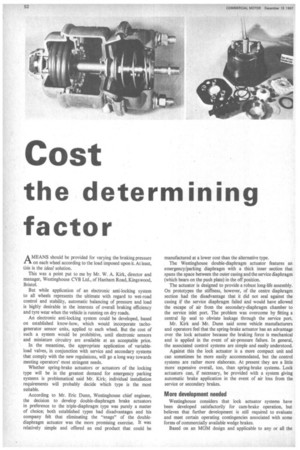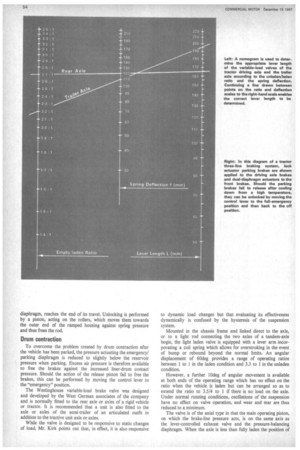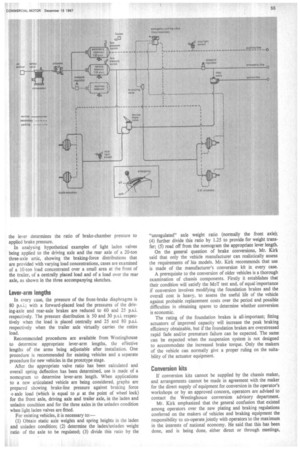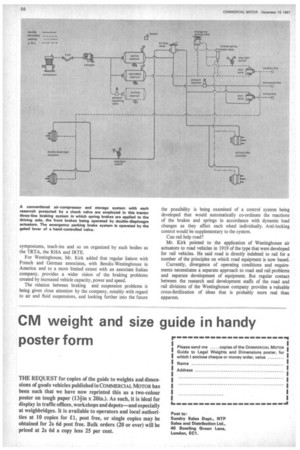Cost the determining factor
Page 54

Page 55

Page 56

Page 57

Page 58

If you've noticed an error in this article please click here to report it so we can fix it.
By P. A. C. Brockington,
AM I MechE
A MEANS should be provided for varying the braking pressure rx on each wheel according to the load imposed upon it. At least, this is the ideal solution.
This was a point put to me by Mr. W. A. Kirk, director and manager, Westinghouse CVB Ltd., of Hanham Road, Kingswood, Bristol.
But while application of an electronic anti-locking system to all wheels represents the ultimate with regard to wet-road control and stability, automatic balancing of pressure and load is highly desirable in the interests of overall braking efficiency and tyre wear when the vehicle is running on dry roads.
An electronic anti-locking system could be developed, based on established know-how, which would incorporate tachogenerator sensor units, applied to each wheel. But the cost of such a system would be prohibitive, until electronic sensors and miniature circuitry are available at an acceptable price.
In the meantime, the appropriate application of variableload valves, in conjunction with service and secondary systems that comply with the new regulations, will go a long way towards meeting operators' most stringent needs.
Whether spring-brake actuators or actuators of the locking type will be in the greatest demand for emergency parking systems is problematical said Mr. Kirk; individual installation requirements will probably decide which type is the most suitable.
According to Mr. Eric Dunn, Westinghouse chief engineer, the decision to develop double-diaphragm brake actuators in preference to the triple-diaphragm type was purely a matter of choice; both established types had disadvantages and his company felt that eliminating the "snags" of the doublediaphragm actuator was the more promising exercise. It was relatively simple and offered an end product that could be manufactured at a lower cost than the alternative type.
The Westinghouse double-diaphragm actuator features an emergency/parking diaphragm with a thick inner section that spans the space between the outer casing and the service diaphragm (which bears on the push plate) in the off position.
The actuator is designed to provide a robust long-life assembly. On prototypes the stiffness, however, of the centre diaphragm section had the disadvantage that it did not seal against the casing if the service diaphragm failed and would have allowed the escape of air from the secondary-diaphragm chamber to the service inlet port. The problem was overcome by fitting a central lip seal to obviate leakage through the service port.
Mr. Kirk and Mr. Dunn said some vehicle manufacturers and operators feel that the spring-brake actuator has an advantage over the lock actuator because the braking force is mechanical and is applied in the event of air-pressure failure. In general, the associated control systems are simple and easily understood.
Against this the lock actuator is a more compact unit and can sometimes be more easily accommodated, but the control systems are rather more elaborate. At present they are a little more expensive overall, too, than spring-brake systems. Lock actuators can, if necessary, be provided with a system giving automatic brake application in the event of air loss from the service or secondary brakes.
More development needed Westinghouse considers that lock actuator systems have been developed satisfactorily for cam-brake operation, but believes that further development is still required to evaluate and meet certain operating contingencies associated with some forms of commercially available wedge brakes.
Based on an MGM design and applicable to any or all the axles of a vehicle, the Westinghouse spring brake is of the piston-diaphragm type mounted co-axially with a singlediaphragm service unit. According to the type of control employed, it can be used solely for parking or as a secondary/ parking brake, the release of air from the system when it is employed as a secondary brake being controlled to give a braking force proportional to the movement of the lever.
Spring brakes for example, can be applied to one or both .axles of a four-wheeler or to all wheels or just the driving wheels of a tractive unit (equipped with a three-line air system). In a particular application of the first type, the emergency/ parking function is controlled by a hand valve. This valve closes a port to the secondary reservoir and opens a port to atmosphere. A button provides for locking in the parked position.
In a typical case the control of the second type of system comprises 'a gated lever that enables the spring brakes to be used separately for secondary operation of the brakes, if necessary in conjunction with double-diaphragm actuators, or for parking. The air supply to the spring brakes is controlled through an inverse spring valve.
When a split service system is used (that enables the secondary brake to be combined with the service brake) and the spring brakes are employed solely for parking, a simple type of on/off hand-controlled valve can be employed. The question as to whether such a system would meet the code of practice is under review by the MoT. A readily accessible manual release of the screw type is fitted to the outer end of the actuator housing.
The locking mechanism of the Westinghouse lock actuator comprises a ring of rollers, mounted in a ramped housing, which act as a ratchet by wedging between the rod and the ramp when the rod, energized by the emergency/parking diaphragm, reaches the end of its travel. Unlocking is performed by a piston, acting on the rollers, which moves them towards the outer end of the ramped housing against spring pressure and thus frees the rod.
Drum contraction To overcome the problem created by drum contraction after the vehicle has been parked, the pressure actuating the emergency/ parking diaphragm is reduced to slightly below the reservoir pressure when parking. Excess air pressure is therefore available to free the brakes against the increased liner-drum contact pressure. Should the action of the release piston fail to free the brakes, this can be performed by moving the control lever to the "emergency" position.
The Westinghouse variable-load brake valve was designed and developed by the West German associates of the company and is normally fitted to the rear axle or axles of a rigid vehicle or tractor. It is recommended that a unit is also fitted to the axle or axles of the semi-trailer of an articulated outfit in addition to the tractive unit axle or axles.
While the valve is designed to be responsive to static changes of load, Mr. Kirk points out that, in effect, it is also responsive to dynamic load changes but that evaluating its effectiveness dynamically is confused by the hysteresis of the suspension system.
Mounted in the chassis frame and linked direct to the axle, or to a light rod connecting the two axles of a tandem-axle bogie, the light laden valve is equipped with a lever arm incorporating a coil spring which allows for overstroking in the event of bump or rebound beyond the normal limits. An angular displacement of 60deg provides a range of operating ratios between 1 to 1 in the laden condition and 3.3 to 1 in the unladen condition.
However, a further 10deg of angular movement is available at both ends of the operating range which has no effect on the ratio when the vehicle is laden but can be arranged so as to extend the ratio to 3.5/4 to 1 if there is no load on the axle. Under normal running conditions, oscillations of the suspension have no effect on valve operation, and wear and tear are thus reduced to a minimum.
The valve is of the axial type in that the main operating piston, on which the brake-line pressure acts, is on the same axis as the lever-controlled exhaust valve and the pressure-balancing diaphragm. When the axle is less than fully laden the position of
the lever determines the ratio of brake-chamber pressure to applied brake pressure.
In analysing hypothetical examples of light laden valves being applied to the driving axle and the rear axle of a 20-ton three-axle artic, showing the braking-force distributions that are provided with varying load concentrations, cases are examined of a 10-ton load concentrated over a small area at the front of the trailer, of a centrally placed load and of a load over the rear axle, as shown in the three accompanying sketches.
Lever-arm lengths In every case, the pressure of the front-brake diaphragms is 80 p.s.i.; with a forward-placed load the pressures of the driving-axle and rear-axle brakes are reduced to 60 and 25 p.s.i. respectively. The pressure distribution is 50 and 30 p.s.i. respectively when the load is placed centrally and 25 and 80 p.s.i. respectively when the trailer axle virtually carries the entire load.
Recommended procedures are available from Westinghouse to determine appropriate lever-arm lengths, the effective lengths of the arms being adjustable after installation. One procedure is recommended for existing vehicles and a separate procedure for new vehicles in the prototype stage.
After the appropriate valve ratio has been calculated and overall spring deflection has been determined, use is made of a nomogram to determine lever-arm length. When applications to a new articulated vehicle are being considered, graphs are prepared showing brake-line pressure against braking force axle load (which is equal to t at the point of wheel lock) for the front axle, driving axle and trailer axle, in the laden and unladen condition and for the three axles in the unladen condition when light laden valves are fitted.
For existing vehicles, it is necessary to:— (1) Obtain static axle weights and spring heights in the laden and unladen condition; (2) determine the laden/unladen weight ratio of the axle to be regulated; (3) divide this ratio by the "unregulated" axle weight ratio (normally the front axle); (4) further divide this ratio by 1.25 to provide for weight transfer; (5) read off from the nomogram the appropriate lever length.
On the general question of brake conversions, Mr. Kirk said that only the vehicle manufacturer can realistically assess the requirements of his models. Mr. Kirk recommends that use is made of the manufacturer's conversion kit in every case.
A prerequisite to the conversion of older vehicles is a thorough examination of chassis components. Firstly it establishes that their condition will satisfy the MoT test and, of equal importance if conversion involves modifying the foundation brakes and the overall cost is heavy, to assess the useful life of the vehicle against probable replacement costs over the period and possible difficulties in obtaining spares to determine whether conversion is economic.
The rating of the foundation brakes is all-important; fitting actuators of improved capacity will increase the peak braking efficiency obtainable, but if the foundation brakes are overstressed rapid fade and/or premature failure can be expected. The same can be expected when the suspension system is not designed to accommodate the increased brake torque. Only the makers of the vehicle can normally give a proper ruling on the suitability of the actuator equipment.
Conversion kits If conversion kits cannot be supplied by the chassis maker, and arrangements cannot be made in agreement with the maker for the direct supply of equipment for conversion in the operator's workshops or by an approved concern, operators are advised to contact the Westinghouse conversion advisory department.
Mr. Kirk emphasized that the general confusion that existed among operators over the new plating and braking regulations conferred on the makers of vehicles and braking equipment the responsibility to co-operate jointly with operators to the maximum in the interests of national economy. He said that this has been done, and is being done, either direct or through meetings, symposiums, teach-ins and so on organized by such bodies as the TRTA, the RHA and IRTE.
For Westinghouse, Mr. Kirk added that regular liaison with French and German associates, with Bendix-Westinghouse in America and to a more limited extent with an associate Italian company, provides a wider vision of the braking problems created by increased vehicle capacity, power and speed.
The relation between braking and suspension problems is being given close attention by the company, notably with regard to air and fluid suspensions, and looking further into the future the possibility is being examined of a control system being developed that would automatically co-ordinate the reactions of the brakes and springs in accordance with dynamic load changes as they affect each wheel individually. Anti-locking control would be supplementary to the system.
Can rail help road?
Mr. Kirk pointed to the application of Westinghouse air actuators to road vehicles in 1919 of the type that were developed for rail vehicles. He said road is directly indebted to rail for a number of the principles on which road equipment is now based.
Currently, divergence of operating conditions and requirements necessitates a separate approach to road and rail problems and separate development of equipment. But regular contact between the research and development staffs of the road and rail divisions of the Westinghouse company provides a valuable cross-fertilization of ideas that is probably more real than apparent.












































































































